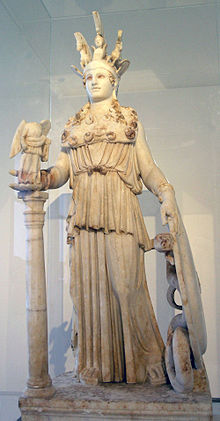
Back أثينا بارثينوس Arabic Афіна Парфенас BE Atena Pàrtenos Catalan Χρυσελεφάντινο άγαλμα της Αθηνάς Greek Atena Partena EO Atenea Pártenos Spanish Atena Partenos EU Athene Parthenos Finnish Athéna Parthénos French Atenea Partenos GL

The statue of Athena Parthenos[N 1] (Ancient Greek: Παρθένος Ἀθηνᾶ, lit. 'Athena the Virgin') was a monumental chryselephantine sculpture of the goddess Athena. Attributed to Phidias and dated to the mid-fifth century BCE, it was an offering from the city of Athens to Athena, its tutelary deity. The naos of the Parthenon on the acropolis of Athens was designed exclusively to accommodate it.
Many artists and craftsmen worked on the realization of the sculpture, which was probably built around a core of cypress wood, and then paneled with gold and ivory plates. At about 13 meters high, the statue reflected the established aesthetic canon of the severe style (clothing) while adopting the innovations of the high classical (leg position). She was helmeted and held a large round shield and spear, placed on the ground to her left, next to her sacred snake. Clothes, jewellery, accessories, and even the statue base were decorated, mainly with the snake and gorgon motif.
The statue was lost at an unknown date sometime in the first millennium. Several replicas and works were inspired by the original.
Cite error: There are <ref group=N> tags on this page, but the references will not show without a {{reflist|group=N}} template (see the help page).